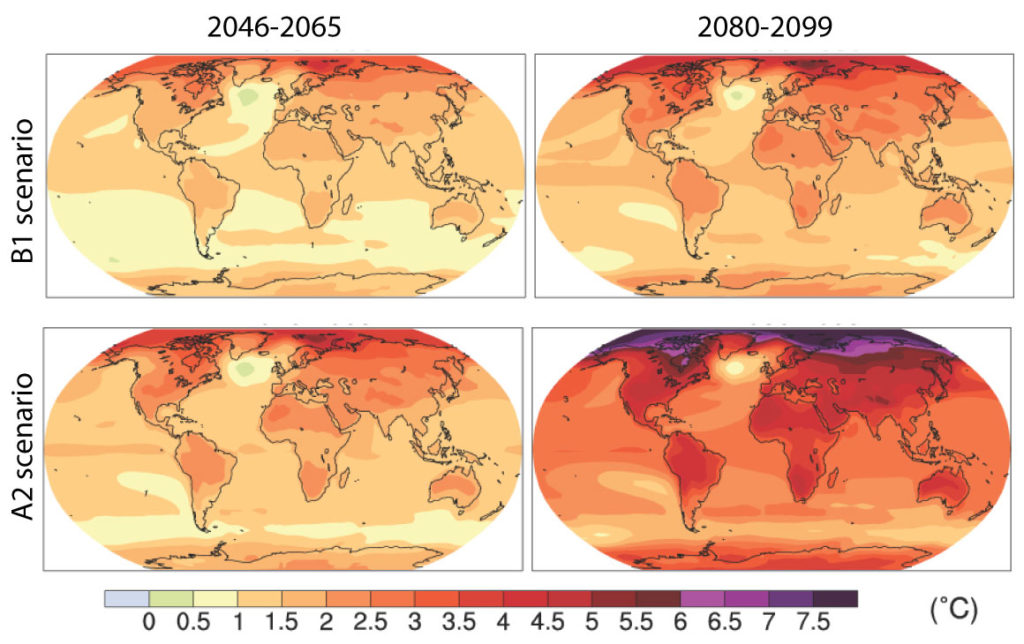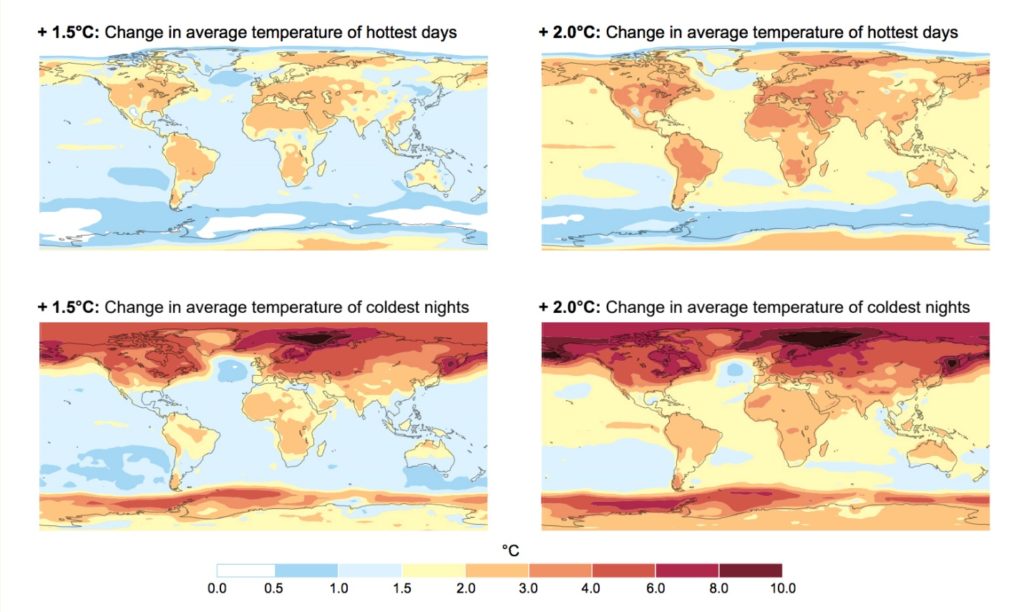Climatologists say that civilization can’t survive global warming of 4oC over the pre-industrial average. Some climatologists even say that civilization can’t survive 3oC. A temperature increase of 4oC over the pre-industrial average sounds fairly trivial so why would that cause civilization to collapse?
First, for Americans, a 4.0oC temperature increase corresponds to a 7.2oF temperature increase. Maybe that still doesn’t sound too bad but it’s a big problem because the 7.2oF increase is an average over the globe and the temperature increase will not be homogeneous.
Some places will warm more than 7.2oF and some places less than 7.2oF. The regions that will warm substantially more than 7.2oF include high latitude regions and large landmasses. We can see that happening already with the global temperature change over the last 50 years (See Figure 1):

Figure 1: Global Temperature Change from 1951-1980 to 2011-2020 (From NASA)
Figures II and III are projections of future warming across the globe:

Figure II: Average annual air temperature change (°C) at the Earth surface for two scenarios of future climate relative to the average of temperature between 1980 to 1999

Figure III-Warming during days and nights (Maps from NASA)
Not only will temperatures be higher in the future, but precipitation patterns will change over time, illustrated by predictions from the U.S. National Center for Atmospheric Research shown in Figure IV:

Figure IV-Predictions of future precipitation changes from the National Center for Atmospheric Research
Hotter and drier conditions will make growing food more challenging. As it is now, a substantial amount of agricultural production in the U.S., as well as in other countries, takes place in regions that rely on irrigation, particularly in the southwestern U.S. and the Great Plains. The water for irrigation comes from both surface water and aquifer sources.
There are multiple problems with relying on irrigation to grow food. First, the water can become less available over time. In the southwestern U.S., drought conditions over the last 20 years have reduced the available surface water for agriculture. Lakes Mead and Powell (Colorado River) as well as other large reservoirs throughout California and the southwest are presently running 40% or less of maximum capacity and are certain to decline further in the future.
Also, aquifers such as the Central Valley (California) and Ogallala (Great Plains) are being over-drafted, more water is being taken out than the amount of water added to the aquifers, by a significant amount. I recently heard that the state of California is going to reduce water extraction from the Central Valley Aquifer by 70% in coming years due to the over-drafting problem.
Almost all of the water from the Central Valley Aquifer goes towards agriculture. According to the book Cadillac Desert, 1/3rd of U.S. table food came from California in the 1980s and that figure probably hasn’t changed much since then. Farmers in the southwest and California are having to abandon fields due to lack of water now and it will get worse in the future.
Second, surface reservoirs, even very large reservoirs, silt up over time which eliminates their capacity to store water. The process can range from years to centuries depending on the rate of erosion above the reservoir. The Colorado River is notorious for carrying a high silt load.
Third, a common problem with irrigation is salt damage to the soil, particularly in hot arid regions. Salt, in the irrigation water or brought up in the soil from below, accumulates on the surface over time rendering the soil worthless or very poor for growing crops.
The global human population is now about 8 billion people. A population of that size would not be possible without wide scale irrigation. The future is going to be that much more challenging to feed even more humans with a climate that gets progressively hotter and drier, especially when the problems mentioned above are included. I expect that nature will make adjustments to future population size.
I almost never hear any mention of human population size when it comes to the issue of climate disruption. Population size and level of consumption are two major factors that determine the level of human greenhouse gas emissions. If the average level of consumption were the same and human population size was 0.8 billion rather than 8 billion, that would make the level of CO2 emissions 1/10th of the present level. That would make the issue of climate disruption much less substantial than it is now.
On one side of the U.S. political fence, Republicans, in general, say that global climate disruption is a hoax. Republican politicians, in general, have to say that because they depend on financial backing from funding sources which basically require that their politicians say global warming is a hoax.
Some Republican politicians probably believe that global climate disruption is a hoax irrespective of the overwhelming evidence to the contrary. Not desiring to get into the evidence in detail, I will only say that all national and international scientific institutions that have made statements about global climate disruption agree that it is occurring and that it is due to human activity.
In the U.S., scientific organizations which state that the climate science is solid include the National Academy of Sciences, the American Association for the Advancement of Science, the American Geophysical Union and the American Chemical Society. Stating that the science is a hoax means nothing has to be done to address the issue. That fits well with the fossil fuel industry that makes money off of selling fossil fuels and for those who promote a free-market ideology wherein money is more important than anything else.
On the other side of the fence, most Americans on the left, including numerous environmental groups, push the idea that renewable energy sources can be used to power the American lifestyle. That is a very comforting message because it says no sacrifices in the American lifestyle are required to reduce greenhouse gas emissions. Just go on with your life and the government will solve the problem by forcing industry to make changes.
The evidence is sufficient to show that we aren’t going to run our present high consumption lifestyles merely on renewables. A look at Germany’s effort with its Energiewende program illustrates the problems when trying to switch from fossil fuels to renewables.
The Energiewende program started in the late 1990s. In the first 22 years of the program, per capita CO2 emissions in Germany dropped about 19%, which is nice, but Germany still has one of the highest per capita CO2 emission rates in Europe (See Table I).
Per capita CO2 emissions for several major European countries and the U.S. in 2018
| Country | Metric Tons CO2 |
| United States | 15.24 |
| Netherlands | 8.77 |
| Germany | 8.56 |
| Denmark | 5.76 |
| United Kingdom | 5.40 |
| France | 4.62 |
| Sweden | 3.54 |
Table I
Some of that 19% reduction could be associated with German industry moving to other countries or Germany increasing imports of electricity from other countries.
It isn’t like Germany hasn’t made a concerted effort to make Energiewende successful. In recent years Germany has spent an average of $36 billion annually on the program and probably well over $500 billion total.
Looking back at Table I, it’s not surprising that the U.S. has among the highest per capita CO2 emission rates in the world. If nothing else, Americans are gluttonous. I was surprised that the Netherlands had a per capita CO2 emission rate as high as it is considering their extensive bicycling and walking infrastructure but CO2 emissions come from more than transportation.
European countries and the U.S. import a lot of consumer products from developing countries such as China. The CO2 emissions associated with those products are credited to the exporting countries like China rather than the country importing the products. China can then be blamed for its high and increasing CO2 emissions and the importing countries can be smug about their reduced CO2 emissions while global CO2 emissions, in general, increase.
One aspect of renewable energy sources that promoters ignore is that making windmills, solar cells, and energy storage systems, such as batteries, requires lots of fossil fuel energy that generate lots of CO2 emissions. There are also CO2 emissions associated with installing and maintaining the infrastructure. Because of the intermittency of wind and solar, backup energy supplies are necessary that generally involve the use of fossil fuels.
I hear climatologists, and many others, state even now that if the U.S. starts to move rapidly to renewable energy sources and other countries start to take international climate disruption agreements seriously, we can hold global warming to 2.0oC or even 1.5oC.
I think that is delusional. First, it would take a monumentally rapid decrease in fossil fuel use to make that happen and that is not realistic. Second, world leaders aren’t going to do anything to impede economic growth because that is what the economic system is all about, growth at all cost. That growth is not realistically possible without fossil fuels.
Populations within countries want more consumer goods and a higher standard of living even if it means destroying the planet. All those consumer products that people buy require fossil fuels in the processes of resource extraction, resource refinement, product manufacturing and transport. Few people are willing to make any kind of significant sacrifices, particularly in the U.S., to reduce consumption. Copious consumption is what Americans live for. In the U.S., the vast majority of people won’t go anywhere without a motor vehicle or do any work without a machine that typically runs on a fossil fuel. It’s not a population that is interested in sacrifice.
To seriously address global climate disruption would require great personal sacrifices. It’s much easier to say climate disruption is a hoax or that renewable energy sources will solve all our problems so we don’t need to do anything on a personal level. It’s also easier to push sacrifices into the future as opposed to making sacrifices now.
I don’t see the present economic system as being capable of dealing with global climate disruption. The system is based upon infinite growth as well as the exploitation of whoever or whatever to maximize profits. It is also about maximizing consumption, not minimizing it.
The present economic system is about the individual, not about the common good. Dealing with climate disruption would require a total emphasis on the common good. It doesn’t appear like the present economic system is going to change significantly anytime soon, unless it collapses, so the common good will continue to take a back seat to individual rights in the economic system.
Another issue which isn’t being factored into the situation by those claiming we can hold warming to 1.5 or 2.0oC is positive feedback. I expect significant positive feedback in the future due to CO2 and methane being released from melting permafrost as well as melting methane hydrates in places like the East Siberian Continental Shelf. That would add onto whatever humans contribute to the atmosphere.
In U.S. polls on issues of concern, climate disruption is well down the list, if it’s on the list at all. I imagine the thinking of those polled is that if climate disruption is of any concern, it’s a concern for well into the future. It’s worth considering that today’s children could still be around in 2100 and beyond when the global temperature increase could be 3oC and higher. We are going to see if civilization can continue at that temperature and above. I don’t think it will end well.
Teaser Photo by Giorgio Parravicini on Unsplash





